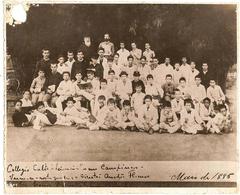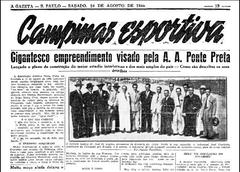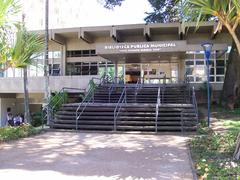
Basilica of Our Lady of Carmel, Campinas: Visiting Hours, Tickets, and Travel Guide
Date: 03/07/2025
Introduction
Located in the historic heart of Campinas, São Paulo, the Basilica of Our Lady of Carmel (Basílica Nossa Senhora do Carmo) is a landmark where centuries of faith, architecture, and community converge. From its humble beginnings in 1774 as a straw-roofed chapel marking the city’s founding Mass to its present form as a neo-Gothic masterpiece, the basilica represents the evolution of Campinas itself. Today, it serves as both a vibrant center of worship and a must-see destination for travelers, history enthusiasts, and pilgrims. This guide provides comprehensive information on visiting hours, accessibility, tickets, key architectural features, and practical travel tips to ensure a rewarding visit. (HelloTravel, Wikipedia, CatholicShrineBasilica.com)
Historical Overview
Colonial Foundations
The basilica’s history is deeply intertwined with that of Campinas. In 1774, a modest chapel was erected on what is now Largo do Carmo, serving as the city’s first place of worship and the locus around which the settlement developed. This original church, built with simple materials, was the heart of the early community, marking the beginning of Campinas’s enduring Catholic tradition. (Wikipedia)
Growth Through the Empire and Parish Development
During the 18th and 19th centuries, the church was central to the life of Campinas, hosting major rites of passage, community events, and religious celebrations. The prosperity brought by the coffee boom in the region enabled significant expansions and artistic enhancements, further solidifying its role as the city’s spiritual and social nucleus. (HelloTravel)
Neo-Gothic Transformation
Between 1930 and 1934, the basilica underwent a dramatic transformation. The “old main church” was largely demolished, preserving only the main altar and the distinctive twin towers, which were incorporated into a new neo-Gothic structure. This ambitious renovation introduced pointed arches, ribbed vaults, stained glass, and intricate stonework, aligning the basilica with the revivalist architectural trends of early 20th-century Brazil. The contributions of Italian immigrant artisans and local craftsmen are evident throughout the building. (Google Arts & Culture, Wikipedia)
Architectural Highlights
- Façade and Towers: The basilica’s twin towers, remnants of the original church, flank a neo-Gothic façade adorned with pointed arches, lancet windows, and elaborate stone carvings. A prominent rose window above the entrance floods the nave with colored light. (Trek Zone)
- Interior Nave: Inside, a soaring nave lined with slender columns and ribbed vaults creates a sense of spaciousness and elevation. The main altar, a baroque masterpiece, is a focal point, richly decorated with gilded woodwork and sculpted figures.
- Stained Glass: Vibrant stained-glass windows depict biblical scenes, Carmelite saints, and Marian iconography, serving both as art and as a teaching tool for the faithful.
- Chapels and Decorative Elements: Side chapels are dedicated to various saints, each with unique altars and devotional artwork. The Stations of the Cross, rendered in bas-relief along the aisles, invite quiet contemplation.
- Pipe Organ and Ceiling Frescoes: The basilica’s early 20th-century pipe organ and ceiling frescoes depicting Carmelite symbolism are highlights for music lovers and art enthusiasts.
Religious and Cultural Significance
- Basilica Status: Elevated by papal decree, the basilica is a major pilgrimage site, hosting diocesan events, daily Masses, and the annual Feast of Our Lady of Mount Carmel (July 16th), which features processions and community celebrations. (CatholicShrineBasilica.com)
- Community Engagement: The basilica is a hub for social outreach, supporting food drives, educational initiatives, and aid programs for underprivileged residents.
- Heritage Protection: Recognized as a protected monument, the basilica benefits from ongoing restoration efforts funded by the church and local community. Its preservation is vital to Campinas’s urban identity and cultural memory.
Visiting Hours, Tickets, and Accessibility
-
General Visiting Hours:
Monday to Saturday: 7:00 AM – 7:00 PM
Sunday: 7:00 AM – 12:00 PM
(Hours may vary slightly for special events; check official social media or local tourism sites for updates.) -
Admission:
Entry is free. Donations are encouraged to support the basilica’s social and preservation programs. -
Guided Tours:
Guided tours can be arranged on weekends and public holidays, often led by parish volunteers. Most information is in Portuguese, so bringing a translation app or guidebook is recommended for non-Portuguese speakers. -
Accessibility:
Wheelchair ramps and accessible restrooms are available. The main entrance is step-free, but some side chapels may not be fully accessible.
Practical Visitor Tips
- Dress Code: Modest attire is required; shoulders and knees should be covered, especially during services.
- Photography: Permitted (no flash); respect worshippers and signage.
- Best Time to Visit: Early mornings or late afternoons are quieter. Sundays and feast days are busiest.
- Safety: The area is safe during the day; standard urban precautions are advised.
- Language: Portuguese is the main language; some staff may speak basic English.
- Facilities: Restrooms and a small gift shop are available; Wi-Fi is generally not provided inside.
Location and Nearby Attractions
Situated at Praça Bento Quirino, the basilica is easily accessible via public transit, taxi, or on foot from downtown Campinas. Nearby sites include:
- Museu da Imagem e do Som (Museum of Image and Sound)
- Metropolitan Cathedral
- Mercado Municipal
- Local cafés, bakeries, and artisan shops
Events and Religious Services
The basilica’s liturgical calendar is robust, featuring:
- Daily Masses and Sacraments: Open to visitors; schedules are posted at the entrance and online.
- Feast of Our Lady of Mount Carmel: July 16th, with special Masses and processions.
- Choral Concerts and Organ Recitals: Occasionally held in the basilica’s acoustically rich interior.
Community and Social Initiatives
The basilica is a center for charitable works, including food distribution, educational outreach, and support for vulnerable groups. Visitors interested in volunteering or contributing to these programs can inquire at the parish office.
Frequently Asked Questions (FAQ)
Q: What are the current visiting hours?
A: Monday to Saturday, 7:00 AM – 7:00 PM; Sunday, 7:00 AM – 12:00 PM.
Q: Is there an entry fee?
A: No, admission is free.
Q: Are guided tours offered?
A: Yes, on weekends and holidays; inquire in advance.
Q: Is the basilica wheelchair accessible?
A: Yes, though some side chapels may be less accessible.
Q: Can I take photos inside?
A: Yes, without flash, and respectfully.
Q: What is the best way to get there?
A: The basilica is centrally located and accessible by public transportation, taxi, or on foot.
Recommendations for an Enriching Visit
- Attend a Mass or special event for a deeper cultural and spiritual experience.
- Explore the surrounding historic district to appreciate Campinas’s urban evolution.
- Engage with parishioners or volunteers to learn more about the basilica’s heritage.
- Support social initiatives by donating or volunteering.
Conclusion
The Basilica of Our Lady of Carmel stands as a living symbol of Campinas’s spiritual, artistic, and communal life. Its neo-Gothic architecture, vibrant stained glass, and enduring traditions make it an essential stop for anyone seeking to understand the city’s past and present. With free admission, accessible facilities, and a central location, the basilica is welcoming to all—whether you’re a pilgrim, a history buff, or a curious traveler.
For up-to-date schedules, guided tours, and event information, consult the basilica’s official channels or download the Audiala app for audio guides and interactive maps.


















